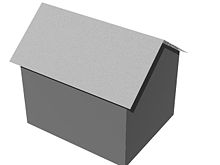- Gable
-
A gable is the generally triangular portion of a wall between the edges of a sloping roof. The shape of the gable and how it is detailed depends on the structural system being used (which is often related to climate and availability of materials) and aesthetic concerns. Thus the type of roof enclosing the volume dictates the shape of the gable. A gable wall or gable end more commonly refers to the entire wall, including the gable and the wall below it.
In Classic Greek and Roman architecture, the analogous feature is called the tympanum. Strictly speaking, the tympanum is the infill area, often triangular, of the pediment, which also consists of the raking cornice or ends of the sloped roofs (which may appear to bear, but do not actually bear on the tympanum - the fact that many tympana bear intricate and expensive carvings declaring the building's purpose is evidence of its non-structural role), and the cornice proper, which bears on the architrave, which in turn is supported at points by columns of a colonnade.
A variation of the gable is a crow-stepped gable, which has a stair-step design to accomplish the sloping portion. Crow stepped gables were used in Scotland and England as early as the seventeenth century. Examples of the crow stepped gable can be seen at Muchalls Castle and Monboddo House, both 17th century Scottish buildings. Other early examples are found in parts of Denmark and Sweden.
A Gothic ornamental gable of the Cathedral architecture over the windows and portal are called in the German and Dutch language Wimperg too.
Gable ends of more recent buildings are often treated in the same way as the Classic pediment form. But unlike Classical structures, which operate through trabeation, the gable ends of many buildings are actually bearing-wall structures. Thus, the detailing tends to be ambiguous, misleading, and to some architects "deceitful". See: John Ruskin and The Seven Lamps of Architecture.
Drawbacks
Gable end roofs are amongst the worst roof designs for hurricane regions. Not only do gable roofs easily peel off in hurricane winds, but according to one hurricane survival guide book, a gable end "catches wind like a sail." When wind flows over a gable roof it behaves much like a wing. Lift is created on the leeward side of the roof. The flatter the roof the more likely this will happen. Steep roofs tend to cause the wind to "stall" as it goes over the roof and breaks up the effect. The addition of a "vertical fin" to low pitched roofs will also help.[1]
See also
- Bell-gable - Espadaña
- Crow-stepped gable
- Dutch gable
- Facade
- Gablet roof
- Hip roof
- Cape Dutch architecture
References
- ^ Roof damage by hurricane force winds in Bermuda The Fabian Experience, September 2003, page 5, Mark Rowe, Department of Environmental Protection, Government of Bermuda
Categories:- Architectural elements
- Walls
- Roofs
Wikimedia Foundation. 2010.

